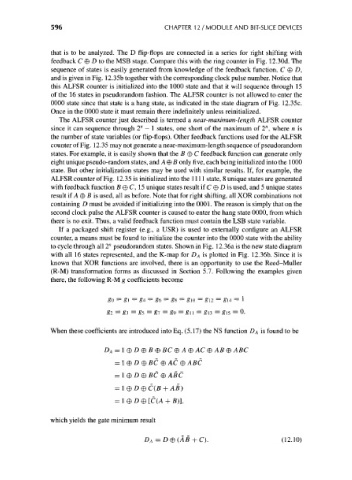Page 626 - Engineering Digital Design
P. 626
596 CHAPTER 12 / MODULE AND BIT-SLICE DEVICES
that is to be analyzed. The D flip-flops are connected in a series for right shifting with
feedback C © D to the MSB stage. Compare this with the ring counter in Fig. 12.30d. The
sequence of states is easily generated from knowledge of the feedback function, C © D,
and is given in Fig. 12.35b together with the corresponding clock pulse number. Notice that
this ALFSR counter is initialized into the 1000 state and that it will sequence through 15
of the 16 states in pseudorandom fashion. The ALFSR counter is not allowed to enter the
0000 state since that state is a hang state, as indicated in the state diagram of Fig. 12.35c.
Once in the 0000 state it must remain there indefinitely unless reinitialized.
The ALFSR counter just described is termed a near-maximum-length ALFSR counter
since it can sequence through 2" — 1 states, one short of the maximum of 2", where n is
the number of state variables (or flip-flops). Other feedback functions used for the ALFSR
counter of Fig. 12.35 may not generate a near-maximum-length sequence of pseudorandom
states. For example, it is easily shown that the B © C feedback function can generate only
eight unique pseudo-random states, and A © B only five, each being initialized into the 1000
state. But other initialization states may be used with similar results. If, for example, the
ALFSR counter of Fig. 12.35 is initialized into the 1111 state, 8 unique states are generated
with feedback function B © C, 15 unique states result if C © D is used, and 5 unique states
result if A © B is used, all as before. Note that for right shifting, all XOR combinations not
containing D must be avoided if initializing into the 0001. The reason is simply that on the
second clock pulse the ALFSR counter is caused to enter the hang state 0000, from which
there is no exit. Thus, a valid feedback function must contain the LSB state variable.
If a packaged shift register (e.g., a USR) is used to externally configure an ALFSR
counter, a means must be found to initialize the counter into the 0000 state with the ability
to cycle through all 2" pseudorandom states. Shown in Fig. 12.36a is the new state diagram
with all 16 states represented, and the K-map for DA is plotted in Fig. 12.36b. Since it is
known that XOR functions are involved, there is an opportunity to use the Reed-Muller
(R-M) transformation forms as discussed in Section 5.7. Following the examples given
there, the following R-M g coefficients become
80 = 8\ = g4 = g6 = #8 = glO = g\2 = g\4 = 1
g2 = #3 = #5 = gl = g9 = gll = #13 = gl5 = 0.
When these coefficients are introduced into Eq. (5.17) the NS function D A is found to be
D A = !©/)©# © 5C ©A© AC ©Afl © ABC
= 1 © D © BC © AC © ABC
= 1 ®D®BC®ABC
= 1 ©Z)©C(5 + AB)
= 1 © £> © [C(A + fl)],
which yields the gate minimum result
D A = D®(AB+C\ (12.10)

